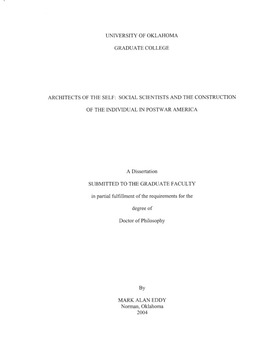| dc.contributor.advisor | Ogilvie, Marilyn B., | en_US |
| dc.contributor.advisor | Taylor, Kenneth L., | en_US |
| dc.contributor.author | Eddy, Mark Alan. | en_US |
| dc.date.accessioned | 2013-08-16T12:19:22Z | |
| dc.date.available | 2013-08-16T12:19:22Z | |
| dc.date.issued | 2004 | en_US |
| dc.identifier.uri | https://hdl.handle.net/11244/712 | |
| dc.description.abstract | American social science experienced unprecedented institutional growth during and after the Second World War due in part to the increased need for techniques in human resource management. As a result, scientific representations of the individual underwent reassessment and modification. This dissertation examines the public careers of two prominent social scientists during the postwar period and their contrasting visions of the individual as an efficient automaton and a multidimensional whole. The psychologist Burrhus Frederic (B. F.) Skinner and the cultural anthropologist Margaret Mead each crafted unique visions of humanity and applied them to critiques of postwar American culture. My research on Mead and Skinner as public intellectuals and as representatives of American culture has three objectives. The first is to explore their scientific depictions of self and society in the context of burgeoning technocracy in twentieth century America. In crafting and developing their theories of the self and of society, Mead and Skinner were both influenced by the social reform movements of the progressive era, the Interwar period, and the 1960s social protest movements. While Skinner's vision of future society entailed a mechanized self and a scientific meritocracy, Mead promoted interdisciplinary social science in service of American democracy and human dignity. The second objective is to examine the popularization of Skinnerian and Meadian science, technology, and social ideology in postwar American culture. My research explores some of the specific ways in which mechanistic and holistic visions of the self and society were appropriated and critiqued by Americans. Skinner's vision of the programmable self had a lasting influence on education and training programs in the United States and abroad. Mead's holistic vision of the self became inextricably linked to the politics of feminism and the youth counterculture in the 1960s. The third objective is to examine how conflicting scientific images of human nature in the postwar decades reflect the modern American tension between the desire for human freedom on the one hand, and systems of social control on the other. Americans have used both of these images of the self selectively to explore individual identity and to refine systems of societal management. | en_US |
| dc.format.extent | xii, 467 leaves ; | en_US |
| dc.subject | Self. | en_US |
| dc.subject | History of Science. | en_US |
| dc.subject | Sociology, Theory and Methods. | en_US |
| dc.subject | Skinner, B. F. (Burrhus Frederic), 1904-1990 | en_US |
| dc.subject | Individualism. | en_US |
| dc.subject | History, United States. | en_US |
| dc.subject | Biography. | en_US |
| dc.subject | Mead, Margaret, 1901-1978. | en_US |
| dc.title | Architects of the self: Social scientists and the construction of the individual in postwar America. | en_US |
| dc.type | Thesis | en_US |
| dc.thesis.degree | Ph.D. | en_US |
| dc.thesis.degreeDiscipline | Department of History of Science | en_US |
| dc.note | Advisers: Marilyn B. Ogilvie; Kenneth L. Taylor. | en_US |
| dc.note | Source: Dissertation Abstracts International, Volume: 65-02, Section: A, page: 0670. | en_US |
| ou.identifier | (UMI)AAI3122296 | en_US |
| ou.group | College of Arts and Sciences::Department of History of Science | |
